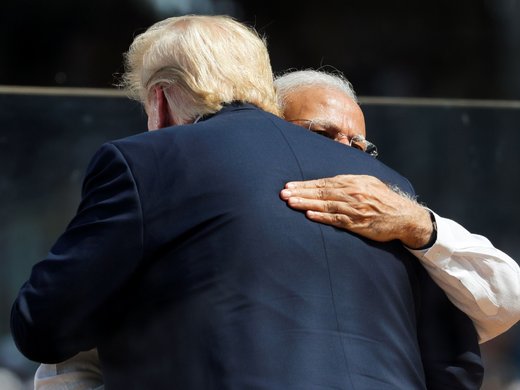Want a tidy explanation for why global trade is suffering? Here’s one from the IMF’s new World Economic Outlook (WEO): China is among the top 10 trading partners for more than 100 countries that account for 80 percent of the world’s gross domestic product. The world’s No. 2 no longer is buying stuff at the frantic rate it was a few years ago -- and almost everyone is feeling it.
Lifeless international markets for goods make up one of many factors that have combined to leave the global economy limping at an “increasingly fragile pace,” according to the WEO, which was released April 12 ahead of semi-annual meetings of the IMF and World Bank this weekend in Washington. The IMF now says the world’s gross domestic product will expand 3.2 percent this year, compared with a previous estimate of 3.4 percent.
The WEO describes an unusually large array of weaknesses. Emerging markets still are struggling to recover from the collapse of commodity prices. The U.S. economy is hiring lots of people, but wages are stagnant and exports were knocked back after the dollar surged last year. Maurice Obstfeld, the IMF’s chief economist, said his profession may not understand well the relationship between cheap commodities and consumption. Plunging oil prices haven’t prompted American consumers to go on a spending spree, meaning there has been little offset for the collapse in investment in commodity-exporting countries. Fiscal policy remains underexploited as a source of stimulus, while monetary policy probably has had its day. “Non-economic” factors such as the exodus of Syrian refugees to Europe and terrorist attacks threaten stability.
And there is China, perhaps the most confounding problem confronting the global economy today. Confounding because policy makers can’t decide whether the country represents a positive or a negative. Beijing’s opaque policy-making in the face of stock-market instability and a massive accumulation of debt inspire little confidence, to be sure. Gillian Tett, the Financial Times editor and columnist, predicts Chinese corporate failures of the type that followed the peak of Japan’s debt-fueled ascendency in the 1980’s. That view is widely held and explains why global markets are troubled so greatly by tremors from China: everyone is waiting for the Big One that brings down everything the global economy has built since the Great Recession.
But what if Beijing keeps it together? The IMF predicts China’s gross domestic product will expand 6.5 percent this year. That’s a significant step down from almost 7 percent in 2015; it also is an upward revision from the fund’s previous 2016 prediction of 6.3 percent. The WEO describes domestic demand as “resilient,” and notes “robust” growth in the services industry is offsetting weaker manufacturing. Stability around these levels of growth would be a positive. Researchers at the Bank of Canada reckon China is capable of maintaining growth rates of around 6 percent, on average, for the next 15 years even as the country seeks more wealth from domestic demand and less from exports. That’s because per capital income still is only about a fifth of that of the United States, meaning there still is lots of headroom to grow without worrying about inflation. China would continue to be a very powerful engine of global economic growth under such a scenario, as its GDP would double over the next decade or so.
“China has the potential to grow at a healthy pace over the longer run, but the transition will take time and there is uncertainty about whether this potential will be fully achieved,” Carolyn Wilkins, senior deputy governor at the Bank of Canada, said in a speech in Vancouver on April 5. “That means China may go through some periods of economic and financial volatility.”
Last year was one such period. The difference between capital leaving the country and money coming in was almost US$675 billion, according to the Institute of International Finance, or IIF. That’s an ugly number, but maybe not as awful as it looks at first glance. Foreign direct investment (FDI) represents about 60 percent of inward capital flows and while it has slowed in recent quarters, net FDI remains positive at about US$153 billion as of the second half of 2015, according to the IIF.
The great shift in China’s capital flows to negative from positive was mostly the result of Chinese shifting money abroad and hottish non-resident money taking flight amid worries about the stability of the renminbi. It would be a mistake to ignore the signal Chinese investors were sending: they lost confidence in their own economy. Wilkins observed in Vancouver that China’s dependence on investment is unsustainable; it was 46 percent of GDP in 2014, compared with 25 percent in other emerging markets and 20 percent in advanced economies. “The strong investment policy is increasingly creating redundant or unproductive capital in China, which may boost growth in the short run but also increases the odds of painful economic adjustments in the future,” she said.
But it also is wrong to be alarmed simply because the numbers are so large. As the IIF noted in its latest capital flows report, it is natural for Chinese investors to accumulate assets abroad; they were doing so in calmer times, and last year’s increase was in line with the previous trend. Also, many Chinese companies are paying off dollar-denominated debt owned abroad. They probably are doing so out of fear the renminbi could depreciate. Still, these are some of the indebted corporations that cause Tett and others such worry. If they are paying off debt, they are reducing a threat to China’s longer-term stability.
The IIF forecasts that net capital outflows from China will slow to US$530 billion in 2016. That’s a negative compared with recent history, but a positive compared with the year that just ended. Policy makers — including Chinese policy makers — could make an important contribution this week in Washington by helping the public understand what is happening in China. The reflex of many is to assume the worst. It’s not clear that the worst-case scenario is what should be driving debate about China. Confidence would benefit from a more reasonable assessment.


